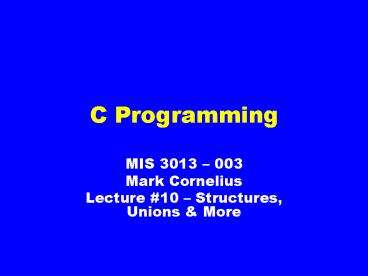C Programming - PowerPoint PPT Presentation
1 / 21
Title:
C Programming
Description:
What is a Structure. How are Structures ... Stdout stream (the CRT Cathode Ray Tube a fancy acronym for MONITOR) ... hint, it has to do with the letter 'F' ... – PowerPoint PPT presentation
Number of Views:39
Avg rating:3.0/5.0
Title: C Programming
1
C Programming
- MIS 3013 003
- Mark Cornelius
- Lecture 10 Structures, Unions More
2
Topics
- What is a Structure
- How are Structures implemented
- How do Structures Work
- The interesting details
- What is a union
- More about input and output
- More about Strings
3
Topics cont.
- Miscellaneous functions with strings
4
Structures
- A collection of variables
- Components, or members may be of different
types (even arrays) - The members are totally at the programmers
discretion - Most similar to a record in a database table.
5
How are Structures Implemented?
- Structures must be defined!!!
- Here is an example
- Struct listing
- Int id_no
- Char lname20, fname20 e_mail20
- Now we have a structure called listing
- But we dont have any listings, because we did
not declare any
6
Implemetation
- We must now declare some variables that are of
type listing. - Struct listing record1, record2
- Now we have two variables that are of the
structure we defined earlier - We can address the members of the structure
individually..
7
Implementation
- Each listing we created, record1 record2,
have members, i.e. - Record1.id_no
- Record1.lnamex
- Record1.fnamex
- Record1.e_mailx
- Which are of the types specified in the
definition of the structure.
8
What does this mean?
- Now we can group related data under a SINGLE
entity, regardless of the type! - Note the similarity between a structure and a
database record. - Structures are the foundation for using linked
lists.
9
Structures and Arrays
- You can create an array of structures
- You can create a multidimensional array of
structures (but why would you?) - You can create pointers to structures
- You can create pointers to structures, that are
MEMBERS of the structure being pointed to (this
is how linked lists work)
10
How do structures work
- Members of structures are accessed individually
(similar to arrays - You can perform any operation on a structure
member that is legal for that type of data. - You can pass structures, or individual members to
functions
11
Unions
- Unions are almost Identical to structures
- They have one key difference
- Only one member of a union can be accessed at a
time - This is because the members are stored together
in memory - With that said..
12
DONT USE UNIONS
- that is, if you dont have to.
- I have spoken!
13
Your mission
- To create an array of 5 structures that contains
the following members - Id_number (integer)
- Gpa (floating point)
- Read in the data from the keyboard.
- Display the result.
- You have 20 Minutes
14
More on I/O
- Thats Input Output, my friend!
15
More on input output
- When reading data from the keyboard, and
displaying to the screen, we are working with 2
files - Stdin stdout
- These are called streams
- There are more streams, I.e. stderr, stdprn (the
printer on lpt1)
16
Standard Input
- Stdin stream
- Reading data from the keyboard
- Gets(), scanf(), getc(), getchar() all default to
the standard input stream - Fgetc() and fgets() are different why?
17
Standard Output
- Stdout stream (the CRT Cathode Ray Tube a
fancy acronym for MONITOR) - Puts(), printf(), putc(), putchar() all default
to the standard output stream - Fputc(), fputs() are different why? (hint, it
has to do with the letter F) - You must learn the use of these commands, and
they are explained in gory detail in chapter 14
18
More about Strings
- Id stick around for this (especially if I
planned on taking C)
19
More about Strings
- We can do a lot of things with strings.we can
- Parse
- Search
- Concatenate
- Bring to uppercase
- Bring to lowercase
- Test for various conditions
- Determine the actual length of the string
20
For example
- If lname20 is an array of characters, I.e. a
string, and is all uppercase - Strlwr(lname) makes it all lowercase
- We could even use isupper and test it.
- There are too many of these functions to
memorize, which is why every sensible programmer
always keeps a syntax guide handy!!!!
21
What is the point?
- Point is, there are times when these functions
come in handy, especially in PRODUCTION Systems































